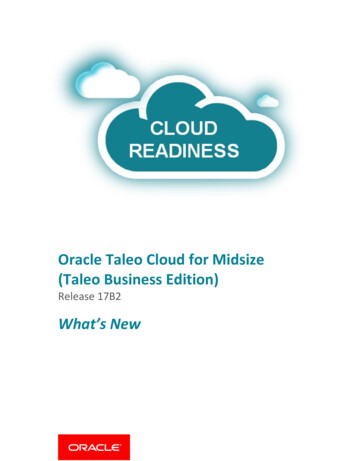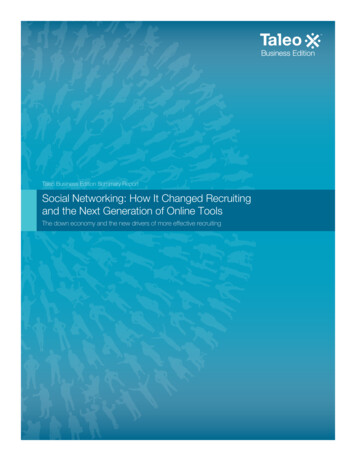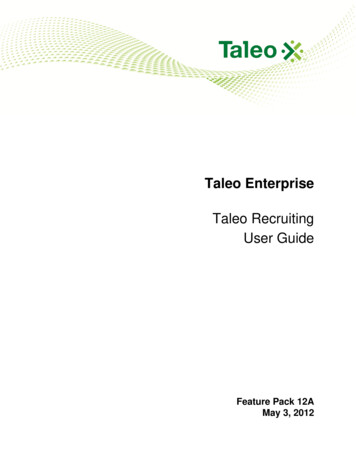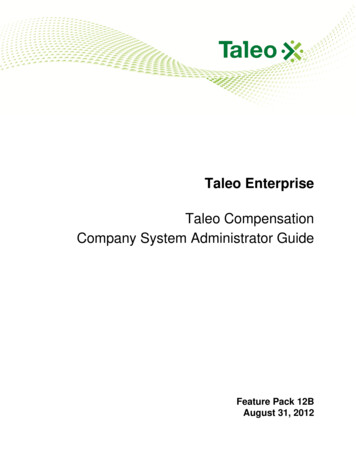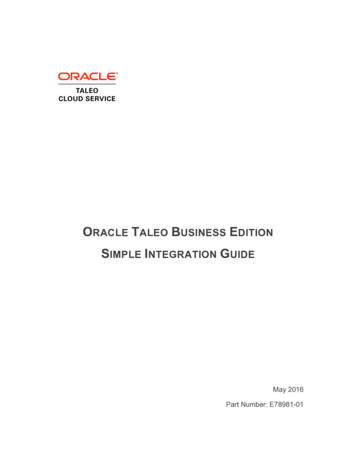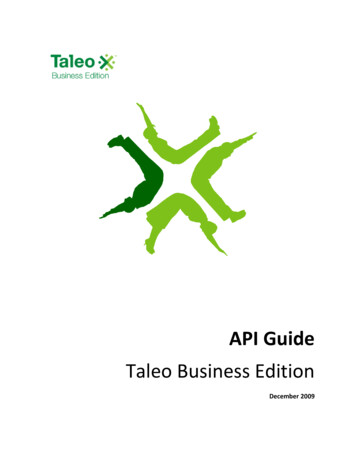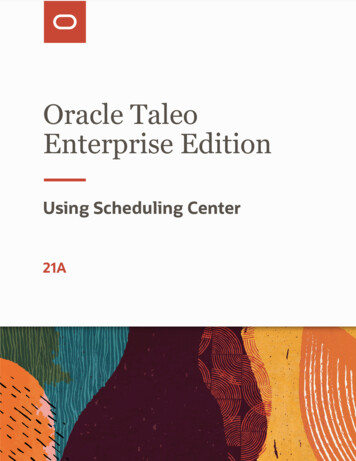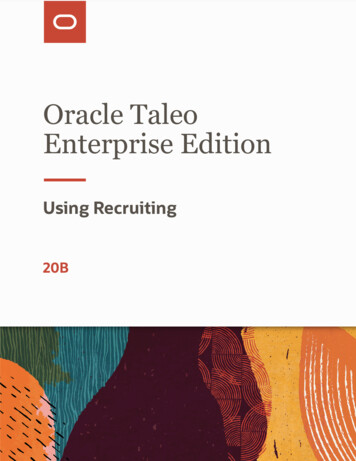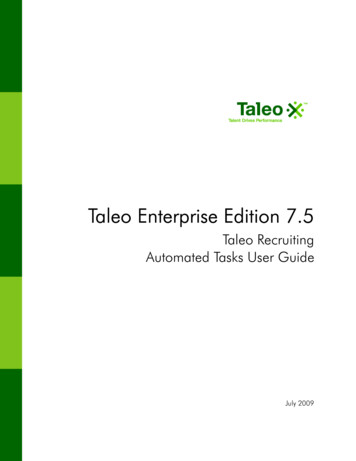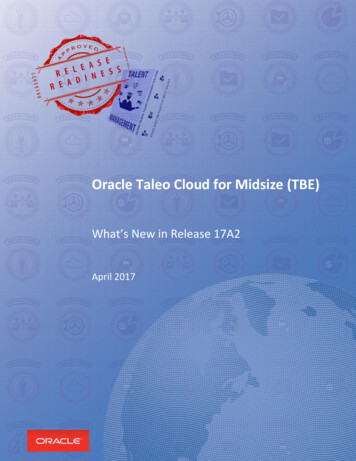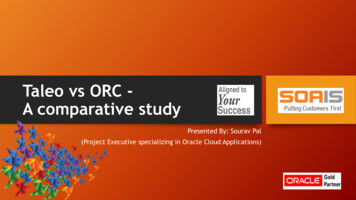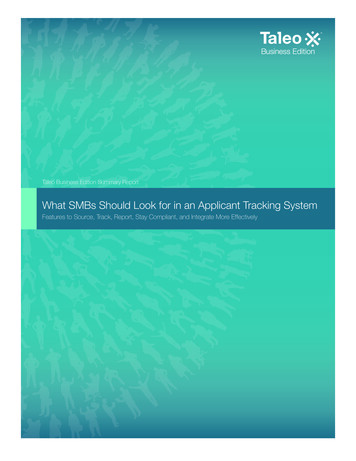
Transcription
Taleo Business Edition Summary ReportWhat SMBs Should Look for in an Applicant Tracking SystemFeatures to Source, Track, Report, Stay Compliant, and Integrate More Effectively
Table of ContentsI. The Looming “War for Talent” . 1Good News and Bad News . 1II. Investing in Technology . 1Productivity Software in Demand. 1The Case for Automating theRecruiting Process . 2III. Selecting an ATS System . 2Affordability . 2Trusting the Vendor . 3Usability. 3Integration . 4Sourcing . 4Tracking and Correspondence . 4Reporting. 5Compliance . 5IV. Living with Your Selection . 5CONTACTwww.taleo.com – info@taleo.com1.877.818.2536 – U.S.1.888.922.5665 – InternationalABOUT TALEOTaleo (NASDAQ: TLEO) is the leader in on demand, web-based talent management solutions that empower organizations of all sizes,around the world to assess, acquire, develop and align their workforce for improved business performance. More than 1,380 organizations use Taleo, including 35 of the Fortune 100, for talent acquisition and performance management, with over 1 million users processing 71 million candidates from over 100 countries. Requiring no capital investment, Taleo’s software as a service and on demand deliveryoffers 99.9% availability.Copyright 2008 Taleo Corporation. All rights reserved. No portion of this document may be reproduced in any form without the prior written permission of Taleo Corporation.Taleo and all Taleo product and service names mentioned herein are trademarks or registered trademarks of Taleo in the United States, France, The Netherlands, U.K., Canada,Australia, and several other countries. All other product and company names mentioned herein may be the trademarks of their respective owners.Facebook is a registered trademark of Facebook, Inc. LinkedIn is a registered trademark of LinkedIn, Inc. All other product and company names mentioned herein may be trademarks of their respective owners.
I: The Looming “War for Talent”Good news and bad newsAmid much uncertainty about the economy, smallto medium-size businesses (SMBs) are preparing togrow. In a survey of 724 SMBs in the US, UK, andCanada, 45 percent predict business will grow bymore than 10 percent in 2008. Two in five expectgrowth to exceed 20 percent. When it comes tostaffing, a full 90 percent plan to add full-timeemployees over the next 12 months, with 33percent preparing to add at least one new businesslocation.1 Given that SMBs are the true growthengines of the world economy, this survey fromthe Computing Technology Industry Association(CompTIA) and AMI-Partners should be welcomenews.More striking, however, is that the optimism issurfacing in the face of a skills shortage. The USBureau of Labor Statistics says that by 2008 thenumber of young adult workers 25-40 years oldwill decline by 1.7 million. By 2010 the US will facea shortage of 10 million workers and an unemployment rate of just two percent. Similar prospectsawait employers in other developed countries.All of this has economists and HR experts alikepredicting a “war for talent.”As more job applicants become cognizant of thedemand for their services, SMBs will feel pinched.Few can offer salaries and benefits on a par withFortune 500 companies. Instead they’ll be forced tooffer qualified applicants other compelling reasonsto join them, assuming they can even find theseapplicants cost effectively. Make no mistake: In theyears ahead, the greatest challenge for SMBs willbe maintaining and increasing the quality of hirewhile reducing the costs and inefficiencies in thehiring process.II: Investing in TechnologyWhether caused by optimism or fear, somethingappears to have lit a fire under SMBs. Increasingnumbers now view technology as a means tocultivate and manage growth. Says John Venator,1 The October 2007 survey of 724 small to medium-size businesses in the US,UK, and Canada was conducted by the Computing Technology Industry Association (CompTIA) and AMI-Partners. All businesses surveyed had 1000 or feweremployees. Copyright 2008 Taleo Corporationpresident and CEO of CompTIA, “Historically,SMBs tended to replace technology reactively whensomething went wrong. Now they are proactivelylooking for solutions that enable them to leverage their networks and boost productivity andefficiency.”Productivity software in demandAmong the top technologies that SMBs have eitherdeployed or plan to purchase in the next 12 monthsis productivity software, with 90 percent of thecompanies surveyed considering its purchase.Table 1: Top technologies that SMBs have eitherdeployed or plan to purchase in the next 12 months(Top six of 20 survey items)1.Desktop PCs98%2.Laptops/Notebooks93%3.Productivity Software Suites90%4.Firewalls79%5.Single-function Laser Printers76%6.Accounting/Tax Software69%CompTIA and AMI-Partners 2007 Spending SurveyProductivity software includes applicant trackingsystems, also known as ATS systems. At a timewhen developing personal connections with viablejob candidates is seen as critical to a company’sgrowth, managing resumes and tracking applicantshas become a losing battle. It makes little differencewhether resumes are paper-based or attached toemail. Recruiters often feel overwhelmed andhiring managers are kept waiting. As the companysuffers, so does the applicant, who often submits aresume only to have it disappear into a black hole.Not only is such an applicant unlikely to becomean employee, anecdotal evidence suggests thecompany may also lose them as a customer.The case for automating the recruiting processContrast the scenario above with one involvingan applicant tracking system. A good ATS systemwill centralize the applicant’s personal data andprovide on-demand availability from anywhere.It offers role-based functionality for requisitions,applicant tracking, interviewing, offers, andWhat SMBs Should Look for in an Applicant Tracking SystemPAGE 1
reporting. At its best, it will enable growth, sourcefor qualified candidates, and ensure compliancewith employment regulations. Will I be able to use it? Will it integrate with my other systems? Will it grow with me?In any objective comparison with a modern ATSsystem, manual recruiting processes will comeout the loser. In the last several years ATS systemshave added functionality for the entire requisitionto-hire process. A handful have been developedspecifically for the SMB market.Of course no two ATS systems offer the same functionality, nor should SMBs expect the same level ofsupport and expertise from every vendor. A goal ofthis paper, then, is to enumerate many of the qualities that SMBs seek in an applicant tracking systemand prepare you to choose a system that will makeyour recruiting efforts more successful.III: Selecting an ATS SystemThe system you select won’t be used only byyour company’s employees. Many others willbe impacted and should influence your decisionalso. These include any third-party recruiters yourcompany employs to source and engage withcandidates, and the candidates themselves. How can I source for qualified candidates? How can I track and correspond with applicants? How can I ensure good reporting? How can I be sure we’re in compliance?AffordabilityThe CompTIA – AMI-Partners spending surveyreveals that pricing and total cost of ownership(TCO) top the list when SMBs go in search oftechnology (Tables 2 and 3). It should come asgood news, then, that ATS vendors are becomingmore aggressive in pricing their products for theSMB market. This is especially true of hostedsolutions that charge a subscription fee based onthe number of users. These software as a service(SaaS) products enable you to eliminate any costsinvolved in storing and maintaining the software,which explains their growing popularity in theSMB market (Table 4). IT personnel reside withthe vendor and ensure that you receive productupgrades as soon as they become available.Allison Boyce, a sourcing manager at DeloitteServices LP, says that candidates take a dim viewof an ATS application that “does not save after eachfield, crashes unexpectedly, is hard to completethoroughly, and yet is viewed as a negative ifit is incomplete.” In fact, she writes on ere.net,it’s one of the “top ten pet peeves” of online jobapplicants.2If that’s one definition of failure, how do we definesuccess? Your evaluation of ATS systems is likelyto involve finding satisfactory answers to thesefrequently asked questions: Can I afford an applicant tracking system?Table 2: SMB Criteria for Selecting Vendors (Top fourof 15 survey items)1.Competitive Pricing94%2.Delivers as Promised91%3.Quality Installation87%4.Knowledgeable Personnel81%Table 3: SMB Criteria for Purchasing IT Products andServices (Top four of nine survey items)1.Total Cost of Ownership76%2.Scalability69%3.Future Integration Capabilities64%4.Brand Leadership57% Can I trust the company?2 Boyce, A, 10 Things Candidates Hate; 10 Things They Love, 47616200E6FC1.asp (November 22, 2007)PAGE 2What SMBs Should Look for in an Applicant Tracking System Copyright 2008 Taleo Corporation
Table 4: Technologies Now Gaining Traction withSMBs1.Custom Software31%2.Web Services and Applications28%3.CRM/Sales Force Automation23%4.Software as a Service (SaaS)20%5.IP Telephony19%6.Storage Area Networks19%7.ERP/Supply Chain Software18%8.Open Source/Linux Applications18%99.9 percent availability? Do they offer fail-safedata centers with redundant high-speed, highvolume internet bandwidth?A good vendor can advise you on best practices,while an excellent one will help you with contentassessment.Where do trust and market leadership rank onyour scorecard? You’ll know the moment you recommend a vendor to your boss and HR colleagues.UsabilityCompTIA and AMI-Partners 2007 Spending SurveyUnlike a larger and more complex EnterpriseResource Planning (ERP) onsite implementation,a hosted ATS installation is typically measuredin days or weeks, depending on the size of yourcompany, your organizational skills in advanceof the installation, and the clarity of your internalrecruiting processes. Studies by talent managementconsultant the Newman Group reveal that mostcompanies are happy with their ATS systems, buta few companies have tried and abandoned one ormore systems. One way to avoid disappointment isto try before you buy. Some vendors will allow youto demo their product as part of a free trial beforepaying user fees. If you’re uncertain whether toinvest in an applicant tracking system, this is oneway to test the waters.Trusting the vendorAll things being equal, SMBs would prefer to gowith a leader. Brand leadership was cited by 57percent of CompTIA’s respondents as a criteriafor purchasing IT products and services, with91 percent saying that a vendor must deliver aspromised. Market leaders have staying power andare more likely to offer a battle-tested product. Thisis especially important to SMBs, who expect tosqueeze more years from their technology and thusrequire a vendor to remain in business longer.Ask the vendor to provide you with their customersatisfaction metrics together with online availability and installation success rates. Can they deliver Copyright 2008 Taleo CorporationIn a sourcing and recruiting survey completed inApril 2007, the Newman Group reports that 40percent of nearly 600 respondents claimed theirATS system doesn’t effectively support their hiringprocesses.3 Almost half said that their systemcouldn’t manage search firm submittals, collectinterview feedback, or create an email campaign tocandidates in the database.A lack of flexibility in defining workflows, capturing applicant data, and tracking applicants asthey move upwards through the organization ispreventing many users from deriving greater valuefrom their ATS systems. These deficiencies becomeeven more glaring if a business is sufficiently largeto have multiple business units or be operating inmore than one country.You want a system that can be configured to workwithin your established processes rather than forceyou into making compromises. You should be ableto customize fields, forms, and workflows easily,and use personalized email templates to communicate with groups or individuals. Ensuring compliance has to be a snap, especially if you contractwith the government.3 2007 Sourcing and Recruiting Survey, developed by the Newman Group. Thesurvey was completed in April 2007 by nearly 600 respondents, 70 percent ofwhom are directly involved in corporate staffing as recruiter, sourcer, or staffingmanagement. The remaining respondents were HR generalists (7 percent), HRexecutives (8 percent), consultants (6 percent), search firm recruiters (10 percent)and vendors (1 percent).What SMBs Should Look for in an Applicant Tracking SystemPAGE 3
“Optimizing the use of an ATS goes hand-in-handwith optimizing recruitment operations,” theNewman Group says. “To be truly effective, ATSsystems must not only support existing internalsystems, they must go beyond a support role towork in harmony with existing processes and systems (such as HRIS) towards achieving a commonfunctional goal.”IntegrationThe larger your business, the more likely you areto have HRIS and financials applications you’llneed to integrate with. An industry-specific ATSsystem – and there are a few, even at the SMB level– can pay off if you do a lot of niche recruiting withspecialized job requirements. Accreditation couldbe one such requirement.Application programming interfaces (API) intoother third-party applications, including externalrecruiters, Microsoft Outlook , job boards, andsocial utilities, will increase your access to jobcandidates and provide even more convenience.Nearly two-thirds of SMBs surveyed by CompTIAand AMI-Partners listed integration as a prioritywhen purchasing IT products and services. Thiswas their third most important criteria, laggingonly TCO and scalability.ScalabilityAn ATS system should function as efficiently foran organization of two-thousand as for a companyof twenty (or even one, if you’re a recruiter withmany clients). As you grow, your ATS systemmust keep pace with you. This is especially truefor SMBs that spin off separate business units orrecruit overseas. In either case multi-language andmulti-currency functionality become mandatory.SourcingWhere does it hurt most? When asked to identifythe cause of their greatest pain, 55 percent ofrespondents to the Newman Group survey citedsourcing. This is more than double the percentagePAGE 4of the second highest vote-getter, candidatequalification and screening.At a time of 5 percent unemployment, with the firstwave of Baby Boomers just beginning to retire andskilled talent in high demand, it’s no wonder thatrecruiters need help with sourcing. Many of theestablished methods of finding candidates – jobboards, career fairs, employee referrals – remainviable, but yields are falling. Too often everyone ischasing the same small pool of job seekers.A good ATS system will integrate candidate assessment tools and direct job board postings, and evenpredict which job boards will be most effective. Itcan root out passive job seekers by tapping intosocial utilities such as LinkedIn and Facebook .And because it’s online and on-demand, it accommodates applicants on their terms, with a maximum of privacy.Use an ATS system to begin building a candidatedatabase. By the time the skilled labor shortagepeaks several years from now, you’ll have a listof qualified job applicants you can engage inconversation.Tracking and correspondenceSuccessful recruiting often occurs over time andincludes multiple conversations. The ability toaccess and refer back to those conversations givesrecruiters and hiring managers a leg up on securingthe best candidates.Candidate management tools will enable you tocreate candidate profiles and send branded emailswithin personalized templates. As more peoplein the organization become responsible for finding and developing talent, the number of peopletouching the ATS system may increase sharply.Workflow must be easily configurable.ReportingYou may be convinced your recruiting is payingoff, while your boss remains skeptical. How doWhat SMBs Should Look for in an Applicant Tracking System Copyright 2008 Taleo Corporation
IV: Living with Your Selectionyou know who’s right? A good ATS system can tellyou. It offers both standard reports and the abilityto compile custom reports easily. Standard reportsshould reveal the number of requisitions filled, thetime-to-fill, and the cost-per-hire. You should beable to slice and dice the ad spend on your variousmedia and learn which job fairs are providing thelargest number of qualified applicants.At a time when SMBs are looking to enhance theirproductivity and recruiters are challenged to meetaggressive recruiting targets, an ATS system canquickly pay for itself. By boosting the quality ofhire cost effectively, a good ATS system provideshuman resource professionals and senior managerswith a smarter way to streamline the hiring processand create higher net returns for the company.Other metrics your boss and you should be able toaccess include the number of completed applications, the number of candidates in the database, thenumber of referrals, source tracking of candidates,and the cost per candidate.ATS systems are as varied as the job candidatesthey process. Like the candidates, they have bothstrengths and weaknesses. This paper wasn’tmeant to provide an exhaustive checklist offeatures and functionality, but to identify importantareas that merit your closest scrutiny.The most effective ATS systems provide real-timeviews on any candidate, requisition, or user. Lookfor complete drilldown capabilities and take a longview on recruiting. In an ere.net column titled, “12Best Recruiting Practices to Copy,” recruiter JohnSullivan says that Dell is a company to emulate,and explains why. “By looking at the number ofnew hires that become top performers within 12to 18 months, they are hitting the nail right on thehead. Great recruiting is not about hiring a largenumber of people or hiring them cheaply; it’s abouthiring individuals who become top performers andwho stay with the organization.”4Many users may access your applicant trackingsystem, but few will be entirely at ease with thetechnology from day one. Remember that eachperson who comes into contact with the systemwill need some level of training. A certain amountof intuitiveness and ease of use will pay bigdividends. As you complete your assessment ofthe various ATS systems, ask yourself if the systemunder consideration will make you and yourcolleagues a little more effective, or a lot moreeffective, and choose wisely.ComplianceAdded to the mix in today’s hiring challenges areconcerns about privacy and transparency, anti-discrimination statutes, and the need for a diversifiedworkforce. Because reducing risk and promotingbest practices are priorities, your system should beable to accommodate EEO, Affirmative Action, andSarbanes-Oxley reporting requirements. It shouldoffer built-in controls for references, certifications, and clearances. Ideally it will be role- anduser-based, capable of filtering data to ensure thatconfidential or potentially prejudicial informationis seen only by the appropriate company contacts,whether administrator, recruiter, or hiring manager.About Taleo Business Editio
www.taleo.com – info@taleo.com 1.877.818.2536 – U.S. 1.888.922.5665 – International ABOUT TALEO Taleo (NASDAQ: TLEO) is the leader in on demand, web-based talent management solutions that empower organizations of all sizes, around the world to assess, acquire, develop and
